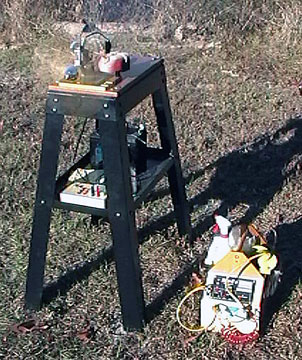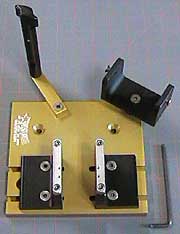Engine Test Stands
 Using an engine test stand
for initial engine runs has many benefits: Using an engine test stand
for initial engine runs has many benefits:
Adjustments are easier to make because the engine is fully exposed. If the
engine is working on the stand but not when you put it in the aircraft, the
needles may need slight tweaking. If that does not work, you can bet the
problem is in the fuel system.
There is either a leak, a kink or some
other feed problem. If you didn't know this you could spend hours
tinkering with the engine before figuring out that you're working on the wrong
thing.
The second benefit of a test stand is that you are not putting unnecessary wear
and tear on your model while breaking in the engine. Running an engine
imposes strain on the airframe.
The airframe should be able to handle it —
after all it is built for the engine you mounted on it. But I still don't see any point in subjecting the model to unnecessary stress
and covering it with exhaust gunk just so I can break in the engine.
If you do choose to break your engine in on the aircraft, at least put the model
on an old table or something and get it out of the dirt.
I have owned a couple test stands and while they were better than nothing at all, I
wasn't real pleased with them either. I finally shelled out some cash for
the excellent PSP manufacturing
stand shown below. It is
heavy duty, easy to use and should last several lifetimes.
 The stand came with a
throttle linkage and a fuel tank which fits in the cradle to the upper right of
the photo. The stand is adjustable for a wide range of engines designed
for beam mounts. The stand came with a
throttle linkage and a fuel tank which fits in the cradle to the upper right of
the photo. The stand is adjustable for a wide range of engines designed
for beam mounts.
I bought a Craftsman tool stand from Sears for about $40. A piece of 3/4"
MDF was given several coats of clear polyurethane to fuel proof it
and then it was bolted to the stand. The PSP test stand is bolted to the
board. It's a simple set up.
The tool stand is heavy enough for the
engines I use but at some point it might be necessary to stake it to the ground
or sandbag it if a large, powerful engine was mounted to the stand.
You will have noticeably better success when you use
some type of test stand to check out your engine.
The PSP test stand doesn't take backplate-mounted engines. In their ads
they mention they have an adapter available but I haven't seen it. This is
an adapter I made in an afternoon to test a bunch of Cox 1/2A engines I have.
The same idea could be applied for larger engines that are backplate-mounted.
Not all my Cox engines have a built-in fuel tank so I made provisions to mount a
small tank.
Comments
from Clarence Lee
|
|
"Regarding engine break-in —
you are correct in saying the engine
should not be given a break-in period in the aircraft but on the bench.
However, contrary to what others have said, bench running break-in is not
near as effective as 'in the air' break-in. It is okay to run a tank or
two of fuel through an engine on the bench to familiarize yourself with it is
operation, but with the engine running static wear patterns, etc., will be
different, operating temperatures different, etc.
A few flights in the air doing big loops, Cuban Eights, etc.
where the engine is working will accomplish more in a few flights than an hour
of bench time. I have seen lapped iron piston engines in the old days that
were given two or three hours of bench running stick up on a first flight due to
the operating temperature increasing under actual load."
|
|
![]()